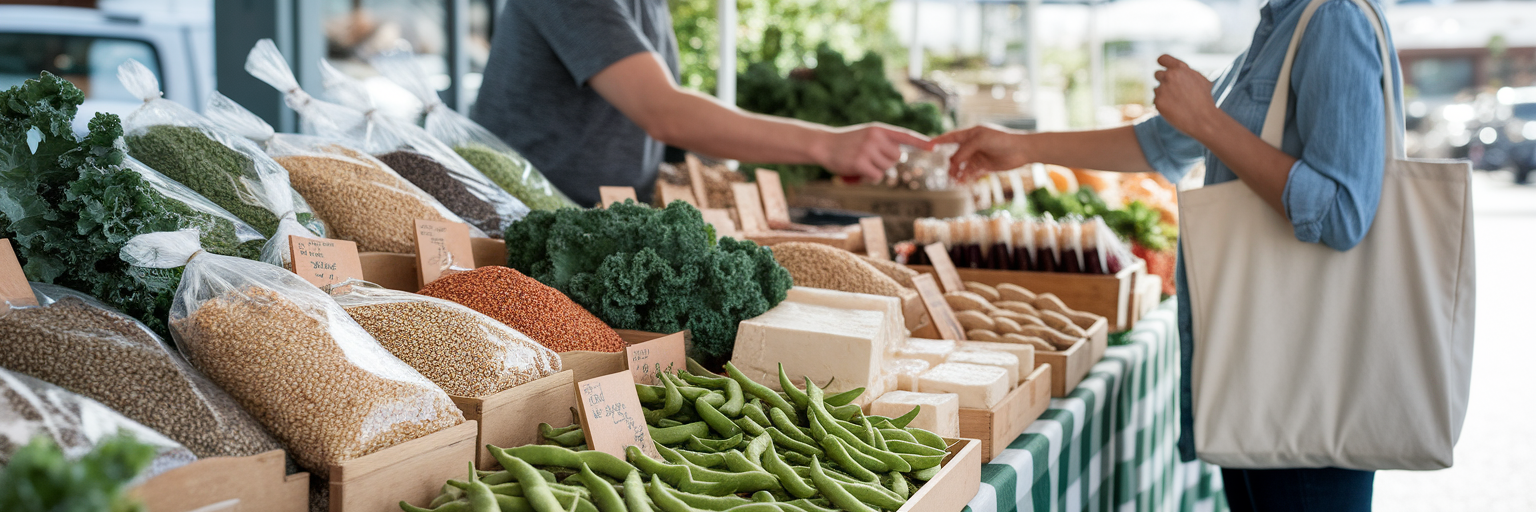The Powerful Link Between Your Plate and the Planet
It might surprise you to learn that what we eat can have a bigger environmental impact than the car we drive. It’s a powerful thought, but it’s also an empowering one. This isn’t about guilt or restriction. Instead, it’s about understanding that small, conscious choices at the grocery store and in the kitchen can create significant, positive change for our planet.
At the heart of this conversation is protein. The decision between plant based protein vs animal protein has a direct and measurable effect on the world around us. Throughout this guide, we’ll look at the real-world data behind this choice, focusing on three key environmental metrics: land use, greenhouse gas emissions, and water consumption.
Our goal is to give you clear, actionable insights that help you understand how to reduce your food carbon footprint. You’ll see how your next meal can be a simple yet meaningful step toward a healthier planet, making you feel informed and capable of making a real difference.
The Heavy Environmental Footprint of Animal Protein

To appreciate the positive impact of plant-based foods, it helps to first understand the environmental costs of animal agriculture. This isn't about pointing fingers but about looking at the systemic effects of our global food system. When we break it down, the resource requirements for producing animal protein are immense.
Land Use: More Than Just a Pasture
The land footprint of animal agriculture is staggering. It’s not just about the space animals need to graze. A huge portion of the world's agricultural land is used to grow crops like corn and soy, not for humans, but for livestock feed. This inefficiency is a major driver of deforestation and habitat loss. According to a report from the Good Food Institute, plants provide nearly two-thirds of the global protein supply while using only one-fourth of all agricultural land, showcasing a stark difference in efficiency.
Greenhouse Gases: A Climate Concern
The connection between animal farming and climate change is well-documented. The United Nations’ Food and Agriculture Organization reports that livestock are responsible for about 14.5% of all human-caused greenhouse gas emissions. A significant portion of this comes from methane, a gas released by cattle that is far more potent than carbon dioxide in the short term. Shifting toward plant-based proteins can dramatically cut these emissions, offering a direct way to address climate change from our kitchens.
Water Consumption: An Unseen Cost
The water footprint of animal protein is another critical factor. While animals do drink water, the vast majority is used for "hidden" purposes, like irrigating the massive fields of feed crops and cleaning farms and processing facilities. Producing a single pound of beef can require thousands of gallons of water, a resource that is becoming increasingly scarce in many parts of the world. This unseen cost adds another layer to the environmental toll of animal-based foods.
The Sustainable Advantage of Plant-Based Proteins
Now for the good news. The conversation around the environmental benefits of vegan protein is incredibly positive and full of potential. Choosing plant-based options isn't just about reducing a negative impact; it's about actively contributing to a more sustainable and regenerative food system.
Think of it in terms of energy efficiency. In ecology, this is known as "trophic levels." When we eat plants directly, we are getting our energy from the source. When we eat animals that ate plants, a huge amount of that initial energy is lost in the process. It’s simply a more efficient and logical way to eat. A comprehensive study in the journal PNAS confirms that plant-based proteins are not only nutritious but are a key element for global food security and environmental safety.
Many plant crops also offer secondary benefits. Legumes like peas, lentils, and beans are nitrogen-fixing, which means they naturally enrich the soil and reduce the need for synthetic chemical fertilizers. This improves soil health and protects our waterways from agricultural runoff. These are the kinds of sustainable protein sources that give back to the earth. And making the switch doesn't mean sacrificing flavor. There are countless delicious and simple dishes you can make, like these 3 easy vegan protein recipes you'll actually crave.
| Resource | Beef (Animal Protein) | Lentils (Plant Protein) | Resource Savings |
|---|---|---|---|
| Land Use (m²) | ~185 m² | ~7 m² | ~96% Less Land |
| Water Use (Liters) | ~15,400 L | ~5,800 L | ~62% Less Water |
| GHG Emissions (kg CO2eq) | ~99 kg | ~0.9 kg | ~99% Fewer Emissions |
Note: Figures are global averages and can vary based on production methods. Data is aggregated from sources including Our World in Data and the Water Footprint Network to illustrate the general scale of impact.
Innovation Driving Sustainable Protein Forward

The shift toward plant-based eating is more exciting than ever, thanks to incredible progress in food science. Gone are the days when "vegan protein" meant a simple block of tofu or a can of beans. For the modern American consumer, the options are now abundant, delicious, and incredibly diverse.
Scientists and chefs are using advanced techniques like fermentation to create next-generation proteins with improved taste, texture, and nutritional profiles. These methods can produce proteins with an even smaller environmental footprint, making sustainable choices even more impactful. This isn't a niche trend; it's a major movement. The vegan protein market is projected to reach $4.82 billion in 2025, reflecting a massive shift in consumer demand.
This growth means more variety and better quality on the shelves of your local supermarket. This innovation extends to supplements, with products like our delicious Chocolate Vegan Protein making it simple to get a sustainable protein boost on the go. An eco friendly protein powder is no longer a compromise on taste or texture. It’s a delicious, convenient part of a modern, conscious lifestyle. You can stay updated on the latest in nutrition and sustainability by checking out our blog.
Making an Eco-Friendly Choice That Works for You
Adopting a more plant-forward diet doesn't have to be an all-or-nothing decision. The most sustainable change is one you can stick with, and even small adjustments can make a big difference. The key is to find what works for your lifestyle and preferences. You’ll be in good company, as reports show that 75% of consumers are interested in trying plant-based alternatives.
Here are a few simple, non-intimidating ideas to get you started:
- Start with "Meatless Mondays." Dedicate one day a week to exploring plant-based meals. It’s a fun, low-pressure way to discover new recipes and flavors.
- Make simple swaps. Try using lentils or mushrooms instead of ground beef in your next batch of chili or pasta sauce. You might be surprised at how hearty and satisfying it is.
- Boost your smoothies. Adding a scoop of vegan protein powder to your morning smoothie is an effortless way to increase your plant protein intake. If you're not sure where to start, this guide to the best protein powders can help you find the perfect fit for your goals.
- Shop smart. When you're at the store, look for brands that are transparent about their sourcing and ingredients. Certifications like USDA Organic and Non-GMO Project Verified can help you make informed choices.
The most important step is the first one. Why not challenge yourself to try one new plant-based meal this week? It’s a small action with a powerful ripple effect.
The Future is Plant-Powered
As we've seen, the choice to prioritize plant protein is one of the most effective ways an individual can support a healthier planet. The collective impact of these choices results in massive savings in land, water, and greenhouse gas emissions. It’s a clear and powerful path forward.
This shift is not about sacrifice. It’s an exciting evolution in how we think about food, one that benefits both our personal health and the health of our environment. Every meal is an opportunity to vote for the kind of world you want to live in. Choosing plants is a powerful vote for a more sustainable and compassionate future.
We believe that a better world begins on our plates, and we are thrilled to be part of this positive change. Ready to explore the delicious possibilities? Check out our full collection of plant-powered products and start your journey today. If this article resonated with you, please share it with a friend or comment below with your favorite eco-friendly meal!



